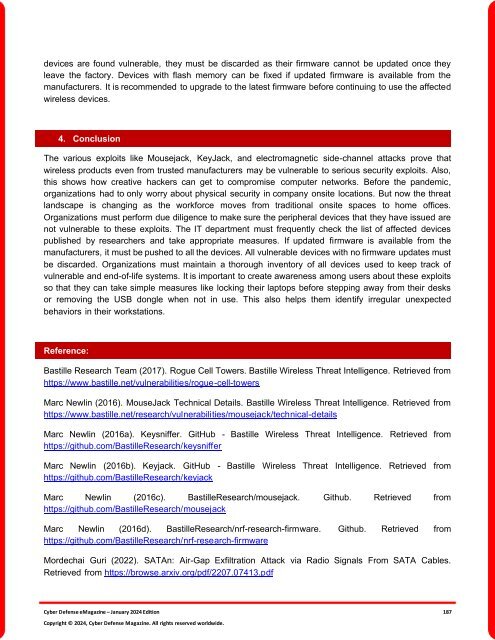The Cyber Defense eMagazine January Edition for 2024
Cyber Defense eMagazine January Edition for 2024 #CDM #CYBERDEFENSEMAG @CyberDefenseMag by @Miliefsky a world-renowned cyber security expert and the Publisher of Cyber Defense Magazine as part of the Cyber Defense Media Group as well as Yan Ross, Editor-in-Chief and many more writers, partners and supporters who make this an awesome publication! 201 page January Edition fully packed with some of our best content. Thank you all and to our readers! OSINT ROCKS! #CDM #CDMG #OSINT #CYBERSECURITY #INFOSEC #BEST #PRACTICES #TIPS #TECHNIQUES
Cyber Defense eMagazine January Edition for 2024 #CDM #CYBERDEFENSEMAG @CyberDefenseMag by @Miliefsky a world-renowned cyber security expert and the Publisher of Cyber Defense Magazine as part of the Cyber Defense Media Group as well as Yan Ross, Editor-in-Chief and many more writers, partners and supporters who make this an awesome publication! 201 page January Edition fully packed with some of our best content. Thank you all and to our readers! OSINT ROCKS! #CDM #CDMG #OSINT #CYBERSECURITY #INFOSEC #BEST #PRACTICES #TIPS #TECHNIQUES
You also want an ePaper? Increase the reach of your titles
YUMPU automatically turns print PDFs into web optimized ePapers that Google loves.
devices are found vulnerable, they must be discarded as their firmware cannot be updated once they<br />
leave the factory. Devices with flash memory can be fixed if updated firmware is available from the<br />
manufacturers. It is recommended to upgrade to the latest firmware be<strong>for</strong>e continuing to use the affected<br />
wireless devices.<br />
4. Conclusion<br />
<strong>The</strong> various exploits like Mousejack, KeyJack, and electromagnetic side-channel attacks prove that<br />
wireless products even from trusted manufacturers may be vulnerable to serious security exploits. Also,<br />
this shows how creative hackers can get to compromise computer networks. Be<strong>for</strong>e the pandemic,<br />
organizations had to only worry about physical security in company onsite locations. But now the threat<br />
landscape is changing as the work<strong>for</strong>ce moves from traditional onsite spaces to home offices.<br />
Organizations must per<strong>for</strong>m due diligence to make sure the peripheral devices that they have issued are<br />
not vulnerable to these exploits. <strong>The</strong> IT department must frequently check the list of affected devices<br />
published by researchers and take appropriate measures. If updated firmware is available from the<br />
manufacturers, it must be pushed to all the devices. All vulnerable devices with no firmware updates must<br />
be discarded. Organizations must maintain a thorough inventory of all devices used to keep track of<br />
vulnerable and end-of-life systems. It is important to create awareness among users about these exploits<br />
so that they can take simple measures like locking their laptops be<strong>for</strong>e stepping away from their desks<br />
or removing the USB dongle when not in use. This also helps them identify irregular unexpected<br />
behaviors in their workstations.<br />
Reference:<br />
Bastille Research Team (2017). Rogue Cell Towers. Bastille Wireless Threat Intelligence. Retrieved from<br />
https://www.bastille.net/vulnerabilities/rogue-cell-towers<br />
Marc Newlin (2016). MouseJack Technical Details. Bastille Wireless Threat Intelligence. Retrieved from<br />
https://www.bastille.net/research/vulnerabilities/mousejack/technical-details<br />
Marc Newlin (2016a). Keysniffer. GitHub - Bastille Wireless Threat Intelligence. Retrieved from<br />
https://github.com/BastilleResearch/keysniffer<br />
Marc Newlin (2016b). Keyjack. GitHub - Bastille Wireless Threat Intelligence. Retrieved from<br />
https://github.com/BastilleResearch/keyjack<br />
Marc Newlin (2016c). BastilleResearch/mousejack. Github. Retrieved from<br />
https://github.com/BastilleResearch/mousejack<br />
Marc Newlin (2016d). BastilleResearch/nrf-research-firmware. Github. Retrieved from<br />
https://github.com/BastilleResearch/nrf-research-firmware<br />
Mordechai Guri (2022). SATAn: Air-Gap Exfiltration Attack via Radio Signals From SATA Cables.<br />
Retrieved from https://browse.arxiv.org/pdf/2207.07413.pdf<br />
<strong>Cyber</strong> <strong>Defense</strong> <strong>eMagazine</strong> – <strong>January</strong> <strong>2024</strong> <strong>Edition</strong> 187<br />
Copyright © <strong>2024</strong>, <strong>Cyber</strong> <strong>Defense</strong> Magazine. All rights reserved worldwide.

















